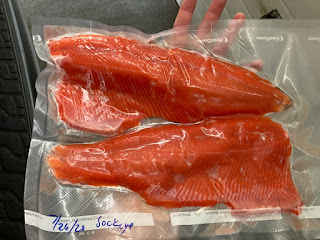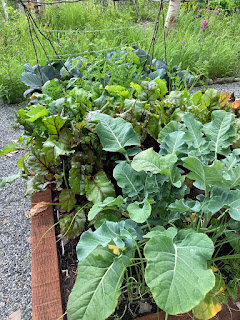
Typically, when I catch a hen salmon, which is always carrying a couple skeins (sacs) of salmon eggs, I just keep the skeins of eggs with the carcass after I filet it and use it to fertilize the garden. But this weekend I decided to try curing some homemade caviar.

The sockeye are running in the creek near the house, so the race is on (again).

No one wanted to go with me today, so I just brought back a one-person limit of 3 reds. All three about average size for this creek, and good color. Here's one of the fish's filets.

So we're packing away some salmon, but we haven't been going through it as fast as previous years, and these fish were added to a chest freezer still nearly full of last year's salmon - meaning I can take my time fishing this season, and only go when I feel like it....no need for 0430 wake-ups this year.

I did a couple of things different this time. First, I kept the 6 skeins of eggs (two per fish, all three fish were hens today), and cured them. You can see the bowl of brine I used to cure the eggs. You can also see some scraps of salmon meat in the plastic bowl - that was the second thing I did different - I used an ice cream scoop to strip all the little scraps of meet left on the carcass after the filets were removed, for later use.

After soaking in the brine, then removing the membranes, then soaking again, we now have a bowl-full of salmon caviar to try out.

Here is our first dish using the caviar - toast with butter (or cream cheese) topped with caviar, garnished with our first cucumber harvested from the garden. Evidently, the goal is to be reminded of the sea as you smell and taste the caviar...I'd say we achieved that affect, as it's very salty, but still has a salmon flavor. The cucumbers work well to chase the salty aftertaste away.

So, the carcasses that I bury in the garden for fertilizer got a little smaller. No skeins of eggs left, and the body scraped of any leftover edible scraps. Here's what's left. Some folks boil the heads and use them, but for now we still put the heads in the garden with the rest of the carcass.

In the past I've dug a deep hole to put them in (which didn't break them down much), or froze them until Fall and tilled them into the garden beds (which worked great last year - they all broke down before planting this Spring), but with ~40 fish each season going in the freezer, it takes up too much room to store the carcasses there. So this year I'm just going to layer them each week as I catch them, into the pile of garden soil I have left over, and hope that I cover it deep enough to keep the animals away.

Today's first three fish buried under about 8 inches of dirt. We'll see how this works out.

The scraps I scraped out with the ice cream scoop, they are fried up here to make salmon patties.


The smell of salmon patties is one of those familiar smells that take me back to when I was a kid.

Jolene's greenhouse tomatoes are all different sizes now, and we're hoping for some sunny days to get the greenhouse hot enough to ripen the large ones. I know tomatoes in the Lower 48 are all nice and ripened now, but in Alaska, it's a big deal to get your tomatoes to ripen before the cold sets back in. So we're excited to watch them grow and (hopefully) ripen up for us this year.

Our potatoes all fell over in our rainstorms and windstorms, then the stalks took a 90 degree turn and grew back to waist height again. These are the beds I put the fish in last year, so I may have too much nitrogen in the soil, making the potatoes grow tall. Hopefully they are putting on spuds as well. Aug 5th will be their 90th day, so I expect they'll start dying back in the next couple of weeks.

Lots of small rain showers this year, and lots of rainbows.

Between the 2018 earthquake, and some natural erosion, our driveway entrance was in need of repair. So we had a paver come out, pull up the damaged asphalt and repave that section.

Unfortunately, there really hasn't been too many days of pure sun without rain, so they ended up paving it in the rain - I'm hoping the rain wasn't heavy enough to degrade the quality of the asphalt they laid.


Compacted and finished. I had planned to re-seal the driveway this year, but with new pavement on one section, I'll wait til next year to seal it all at the same time.

End of day, a moment to relax between rain showers, and enjoy a salmon patty.
Take care, and God Bless!











































